The global AI-defined vehicle market is valued at USD 951.5 million in 2025 and is slated to reach USD 10,386.3 million by 2035, recording an absolute increase of USD 9,434.8 million over the forecast period. This translates into a total growth of 992.0%, with theAI-defined vehicle market forecast to expand at a compound annual growth rate (CAGR) of 27.0% between 2025 and 2035. The overall market size is expected to grow by approximately 10.92X during the same period, supported by rapid advancement in artificial intelligence technologies, increasing adoption of autonomous driving systems across global markets, and rising integration of intelligent cockpit solutions in modern vehicles.
The AI-defined vehicle market represents an emerging segment of the global automotive industry, characterized by accelerating technological innovation and transforming mobility paradigms. Market dynamics are influenced by regulatory developments supporting autonomous vehicle deployment, growing consumer acceptance of AI-powered transportation solutions, and expanding partnerships between traditional automakers and technology companies. Vehicle manufacturers are transitioning from conventional automotive approaches toward comprehensive AI integration that encompasses driving automation, predictive maintenance, and personalized user experiences.
Consumer behavior in the AI-defined vehicle market reflects broader trends toward connected mobility solutions that provide enhanced safety, convenience, and operational efficiency. The AI-defined vehicle market benefits from increasing urbanization patterns that drive demand for intelligent transportation systems, growing environmental consciousness promoting electric vehicle adoption, and rising expectations for seamless digital integration in automotive applications. Advanced driver assistance systems and autonomous capabilities are becoming standard expectations rather than premium features across multiple vehicle segments.
Regional adoption patterns vary significantly, with Asian markets leading in AI technology development and deployment, while North American and European markets demonstrate strong regulatory frameworks supporting autonomous vehicle testing and commercialization. The competitive landscape continues evolving with traditional automotive manufacturers collaborating with AI technology providers to develop comprehensive solutions that address complex mobility challenges in urban environments.
The technological ecosystem features established automotive companies alongside emerging AI specialists that focus on machine learning algorithms, sensor fusion technologies, and real-time decision-making systems. Manufacturing scalability and supply chain coordination remain critical factors for market participants, particularly as semiconductor availability and advanced sensor integration continue influencing production timelines. Distribution strategies emphasize direct partnerships between technology providers and vehicle manufacturers while regulatory compliance frameworks shape deployment approaches across different geographic markets.
Market transformation trends indicate accelerating convergence between automotive manufacturing and artificial intelligence development, creating new business models focused on software-defined vehicles and continuous capability updates. The emergence of AI-powered vehicle platforms enables manufacturers to differentiate through intelligent features, predictive capabilities, and personalized user experiences that extend beyond traditional transportation functions.
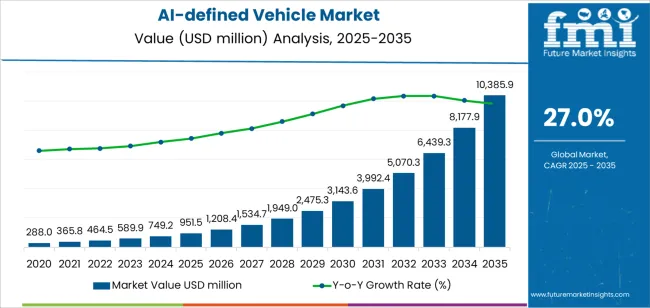
Between 2025 and 2030, the AI-defined vehicle market is projected to expand from USD 951.5 million to USD 3,992.4 million, resulting in a value increase of USD 3,040.9 million, which represents 32.2% of the total forecast growth for the decade. This phase of development will be shaped by accelerating deployment of Level 3 and Level 4 autonomous driving systems, expanding integration of AI-powered vehicle operating systems, and growing adoption of intelligent cockpit technologies with enhanced human-machine interaction capabilities. Vehicle manufacturers are expanding their AI development partnerships to address the growing demand for software-defined vehicles, autonomous capabilities, and connected mobility solutions across consumer and commercial segments.
| Metric | Value |
|---|---|
| Estimated Value (2025E) | USD 951.5 million |
| Forecast Value (2035F) | USD 10,386.3 million |
| Forecast CAGR (2025-2035) | 27.0% |
From 2030 to 2035, the AI-defined vehicle market is forecast to grow from USD 3,992.4 million to USD 10,386.3 million, adding another USD 6,393.9 million, which constitutes 67.8% of the overall ten-year expansion. This period is expected to be characterized by widespread deployment of fully autonomous vehicles, integration of advanced AI operating systems with cloud connectivity, and development of comprehensive mobility-as-a-service platforms with predictive analytics capabilities. The growing adoption of edge computing and 5G connectivity will drive demand for AI-defined vehicles with real-time processing capabilities and seamless integration with smart city infrastructure across urban transportation networks.
Between 2020 and 2025, the AI-defined vehicle market experienced foundational growth, driven by increasing investment in autonomous driving research and growing recognition of AI technologies as transformative components for next-generation mobility solutions across passenger and commercial vehicle applications. The AI-defined vehicle market developed as automotive manufacturers recognized the potential for AI integration to provide enhanced safety features, operational efficiency, and competitive differentiation while enabling new revenue streams through software-based services and continuous capability updates.
Market expansion is being supported by the increasing global demand for autonomous driving capabilities and the corresponding need for intelligent vehicle systems that can provide superior safety characteristics, operational efficiency, and user experience while enabling seamless integration with connected infrastructure and smart city applications. Modern automotive manufacturers and technology companies are increasingly focused on implementing AI-powered solutions that can deliver predictive capabilities, real-time decision-making, and continuous learning functionality throughout complex transportation environments and diverse operating conditions. AI-defined vehicles' proven ability to enhance safety performance against traditional vehicles, enable efficient traffic management, and support sustainable mobility protocols make them essential components for contemporary transportation transformation.
The growing emphasis on road safety improvement and traffic optimization is driving demand for AI-defined vehicles that can support large-scale deployment requirements, improve transportation outcomes, and enable intelligent mobility systems. Consumer preference for vehicles that combine advanced safety features with personalized user experiences and environmental sustainability is creating opportunities for innovative AI implementations. The rising influence of smart city initiatives and connected infrastructure development is also contributing to increased demand for AI-defined vehicles that can provide seamless integration, predictive maintenance capabilities, and optimized performance across extended operational periods.
The AI-defined vehicle market is poised for exponential growth and technological transformation. As consumers across North America, Europe, Asia-Pacific, and emerging markets seek vehicles that deliver exceptional safety performance, intelligent functionality, and sustainable transportation options, AI-defined vehicles are gaining prominence not just as advanced automobiles but as strategic enablers of comprehensive mobility transformation.
Rising autonomous driving adoption in Asia-Pacific and expanding smart city initiatives globally amplify demand, while manufacturers are leveraging innovations in machine learning systems, sensor fusion technologies, and edge computing platforms.
Pathways like Level 4 autonomous capabilities, AI-powered operating systems, and integrated mobility platforms promise strong margin uplift, especially in premium vehicle segments. Geographic expansion and technology integration will capture volume, particularly where regulatory support and infrastructure development are critical.
The AI-defined vehicle market is segmented by type, application, deployment model, vehicle class, technology level, and region. By type, the market is divided into AI Intelligent Driving, AI Intelligent Cockpit, and AI-based Vehicle OS categories. By application, it covers OEMs & Tier-1s and Aftermarket segments. By deployment model, the AI-defined vehicle market includes Cloud-based, Edge-based, and Hybrid configurations. By vehicle class, it comprises Passenger Cars, Commercial Vehicles, and Electric Vehicles. By technology level, the AI-defined vehicle market is categorized into Level 2, Level 3, Level 4, and Level 5 autonomy. Regionally, the AI-defined vehicle market is divided into North America, Europe, East Asia, South Asia & Pacific, Latin America, and the Middle East & Africa.
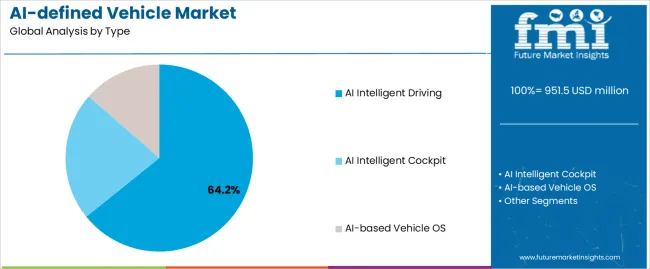
The AI intelligent driving segment is projected to account for 64.2% of the AI-defined vehicle market in 2025, reaffirming its position as the leading type category. Automotive manufacturers and technology providers increasingly utilize AI intelligent driving systems for their superior safety characteristics when operating across diverse traffic conditions, excellent performance reliability, and widespread applicability in applications ranging from highway automation to urban navigation operations. AI intelligent driving technology's advanced perception capabilities and real-time decision-making functionality directly address the consumer requirements for enhanced safety experiences in complex transportation environments.
This type segment forms the foundation of modern autonomous vehicle development, as it represents the technology with the greatest safety impact and established market validation across multiple vehicle categories and deployment scenarios. Manufacturer investments in perception algorithms and decision-making systems continue to strengthen adoption among automotive OEMs and technology integrators. With consumers prioritizing safety enhancement and operational efficiency, AI intelligent driving systems align with both performance expectations and regulatory requirements, making them the central component of comprehensive autonomous vehicle strategies.
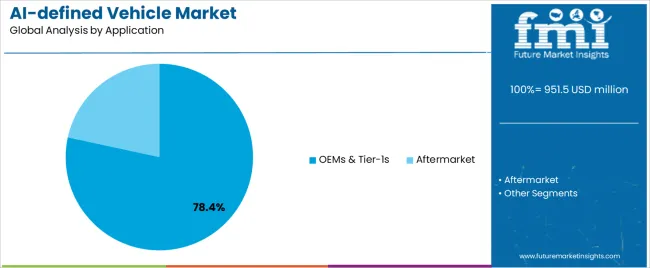
OEMs & Tier-1s applications are projected to represent 78.4% of AI-defined vehicle demand in 2025, underscoring their critical role as the primary deployment channel for AI technologies across vehicle manufacturing, system integration, and original equipment applications. Original equipment manufacturers prefer AI-defined vehicle technologies for their exceptional integration characteristics, scalable deployment options, and ability to enhance vehicle capabilities while ensuring consistent performance throughout diverse operating conditions. Positioned as essential components for modern vehicle platforms, AI systems offer both competitive differentiation advantages and comprehensive functionality benefits.
The segment is supported by continuous innovation in AI algorithms and the growing availability of specialized hardware platforms that enable diverse vehicle applications with enhanced performance consistency and reliable operation capabilities. Additionally, OEMs are investing in comprehensive AI platforms to support large-scale vehicle production and technology integration. As autonomous driving becomes more prevalent and safety requirements increase, OEM applications will continue to represent a major deployment market while supporting advanced vehicle development and regulatory compliance strategies.
The AI-defined vehicle market is advancing rapidly due to increasing demand for autonomous driving capabilities and growing adoption of intelligent vehicle systems that provide superior safety characteristics and operational efficiency while enabling comprehensive mobility transformation across diverse passenger and commercial transportation applications. The AI-defined vehicle market faces challenges, including complex regulatory frameworks, high development costs, and the need for specialized AI expertise and comprehensive testing programs. Innovation in machine learning capabilities and sensor fusion systems continues to influence product development and market expansion patterns.
The growing adoption of autonomous driving technologies, safety enhancement requirements, and regulatory support for AI-powered vehicles is enabling manufacturers to produce advanced AI-defined vehicle systems with superior safety positioning, enhanced operational capabilities, and comprehensive automation functionalities. Advanced AI systems provide improved decision-making consistency while allowing more efficient traffic management and reliable performance across various transportation applications and operating conditions. Manufacturers are increasingly recognizing the competitive advantages of autonomous capabilities for market differentiation and regulatory compliance.
Modern AI-defined vehicle producers are incorporating comprehensive connectivity solutions, vehicle-to-infrastructure communication, and smart city integration capabilities to enhance operational effectiveness, enable coordinated transportation systems, and deliver value-added solutions to mobility customers. These technologies improve traffic optimization while enabling new market opportunities, including predictive routing, dynamic traffic management, and integrated mobility services. Advanced connectivity integration also allows manufacturers to support comprehensive transportation networks and market expansion beyond traditional vehicle approaches.
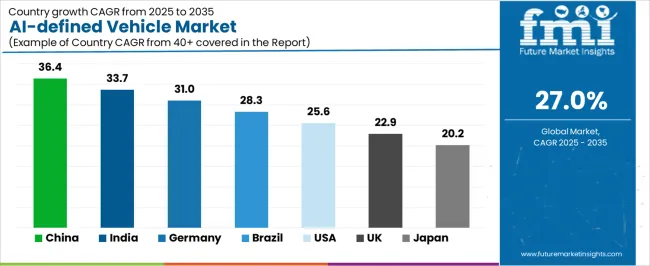
| Country | CAGR (2025-2035) |
|---|---|
| China | 36.4% |
| India | 33.7% |
| Germany | 31.0% |
| Brazil | 28.3% |
| United States (USA) | 25.6% |
| United Kingdom (UK) | 22.9% |
| Japan | 20.2% |
The AI-defined vehicle market is experiencing exceptional growth globally, with China leading at a 36.4% CAGR through 2035, driven by aggressive government support for autonomous vehicle development, massive investment in AI technology infrastructure, and comprehensive smart city initiatives promoting integrated mobility solutions. India follows at 33.7%, supported by rapid digitalization programs, growing automotive manufacturing capabilities, and expanding technology partnerships with global AI providers. Germany shows growth at 31.0%, emphasizing automotive industry transformation and premium technology development. Brazil records 28.3%, focusing on expanding automotive technology adoption and urban mobility modernization. The USA demonstrates 25.6% growth, prioritizing regulatory framework development and technology validation programs. The UK exhibits 22.9% growth, emphasizing AI research advancement and autonomous vehicle testing initiatives. Japan shows 20.2% growth, supported by precision manufacturing capabilities and quality-focused technology development.
The report covers an in-depth analysis of 40+ countries, top-performing countries are highlighted below.
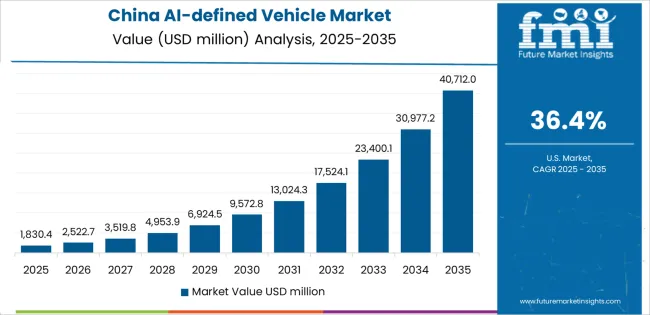
Revenue from AI-defined vehicles in China is projected to exhibit exceptional growth with a CAGR of 36.4% through 2035, driven by comprehensive government support for autonomous vehicle development and rapidly expanding AI technology infrastructure supported by massive investment in smart transportation initiatives promoting comprehensive mobility transformation. The country's dominant position in AI research and development and increasing investment in connected vehicle infrastructure are creating substantial demand for autonomous vehicle technologies. Major automotive manufacturers and technology companies are establishing comprehensive AI development capabilities to serve both domestic market demand and expanding global applications.
Revenue from AI-defined vehicles in India is expanding at a CAGR of 33.7%, supported by the country's rapid digitalization programs, expanding automotive manufacturing sector, and increasing collaboration with global AI technology providers. The country's initiatives promoting technology adoption and growing consumer acceptance are driving requirements for intelligent vehicle systems. International technology companies and domestic manufacturers are establishing extensive development and production capabilities to address the growing demand for AI-powered transportation solutions.
Revenue from AI-defined vehicles in Germany is expanding at a CAGR of 31.0%, supported by the country's automotive industry leadership, strong emphasis on precision engineering, and robust investment in AI technology development for transportation applications. The nation's advanced automotive manufacturing sector and technology-focused operations are driving sophisticated AI vehicle systems throughout the automotive industry. Leading manufacturers and technology providers are investing extensively in autonomous driving development and AI integration technologies to serve both domestic and international markets.
Revenue from AI-defined vehicles in Brazil is growing at a CAGR of 28.3%, driven by the country's expanding automotive technology sector, growing urban mobility programs, and increasing investment in intelligent transportation development. Brazil's large automotive market and commitment to technology advancement are supporting demand for AI vehicle solutions across multiple transportation segments. Manufacturers are establishing comprehensive development capabilities to serve the growing domestic market and expanding urban mobility opportunities.
Revenue from AI-defined vehicles in the USA is expanding at a CAGR of 25.6%, supported by the country's advanced automotive technology sector, strategic focus on regulatory framework development, and established technology validation capabilities. The USA's automotive innovation leadership and comprehensive testing infrastructure are driving demand for autonomous vehicle technologies in research, development, and commercial deployment applications. Manufacturers are investing in comprehensive technology validation to serve both domestic market requirements and international technology applications.
Revenue from AI-defined vehicles in the UK is growing at a CAGR of 22.9%, driven by the country's focus on AI research advancement, emphasis on autonomous vehicle testing, and strong position in automotive technology development. The UK's established automotive research capabilities and commitment to technology innovation are supporting investment in AI vehicle technologies throughout major automotive regions. Industry leaders are establishing comprehensive technology development systems to serve domestic automotive applications and international technology markets.
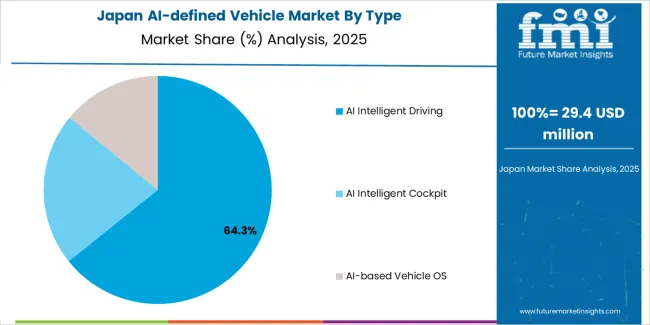
Revenue from AI-defined vehicles in Japan is expanding at a CAGR of 20.2%, supported by the country's precision manufacturing initiatives, growing automotive technology sector, and strategic emphasis on quality-focused development. Japan's advanced manufacturing capabilities and integrated automotive systems are driving demand for high-precision AI vehicle technologies in automotive manufacturing, technology development, and premium vehicle applications. Leading manufacturers are investing in specialized capabilities to serve the stringent requirements of quality-focused automotive and premium technology industries.
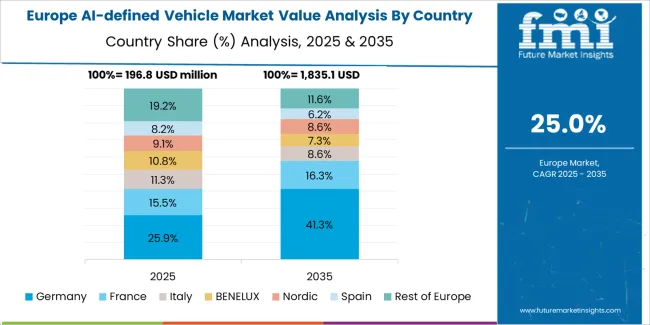
The AI-defined vehicle market in Europe is projected to grow from USD 185.3 million in 2025 to USD 2,024.7 million by 2035, registering a CAGR of 27.8% over the forecast period. Germany is expected to maintain its leadership position with a 42.5% market share in 2025, declining slightly to 41.8% by 2035, supported by its dominant automotive industry presence, comprehensive AI research capabilities, and established technology development infrastructure serving diverse autonomous vehicle applications across Europe.
France follows with a 18.7% share in 2025, projected to reach 19.2% by 2035, driven by robust investment in autonomous vehicle research, government support for AI technology development, and established automotive manufacturing capabilities combined with comprehensive testing infrastructure and regulatory advancement. The United Kingdom holds a 14.2% share in 2025, expected to reach 14.8% by 2035, supported by strong AI research sector and growing autonomous vehicle testing activities. Italy commands a 10.8% share in 2025, projected to reach 11.3% by 2035, while Spain accounts for 7.9% in 2025, expected to reach 8.2% by 2035. The Netherlands maintains a 3.6% share in 2025, growing to 3.8% by 2035. The Rest of Europe region, including Nordic countries, Eastern Europe, Belgium, Austria, and other nations, is anticipated to maintain momentum, with its collective share moving from 2.3% to 0.9% by 2035, attributed to increasing automotive technology adoption in Eastern Europe and growing AI development penetration in Nordic countries implementing advanced technology programs.
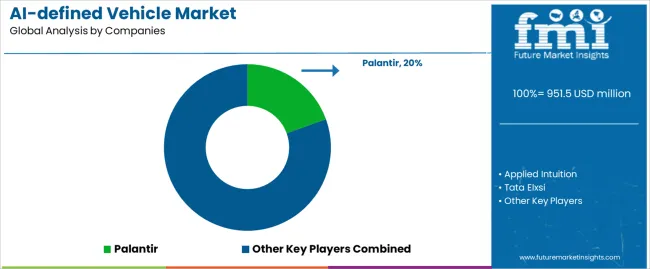
The AI-defined vehicle market is characterized by competition among established technology companies, automotive manufacturers, and specialized AI solution providers. Companies are investing in machine learning algorithm development, sensor fusion optimization, autonomous driving system advancement, and comprehensive AI platform portfolios to deliver reliable, high-performance, and application-specific AI-defined vehicle solutions. Innovation in deep learning systems, edge computing integration, and real-time processing capabilities is central to strengthening market position and competitive advantage.
Palantir leads the AI-defined vehicle market with a strong market share, offering comprehensive AI analytics solutions, including advanced data processing and predictive analytics systems, with a focus on autonomous vehicle development and intelligent transportation applications. Applied Intuition provides specialized simulation platforms with an emphasis on autonomous vehicle testing and validation systems. Tata Elxsi delivers comprehensive automotive technology solutions with a focus on AI integration platforms and connected vehicle services. Lotus Cars specializes in premium vehicle development and advanced automotive technologies for luxury applications. XPENG focuses on intelligent electric vehicles and innovative AI integration solutions. Li Auto offers advanced electric vehicle platforms with emphasis on AI-powered user experiences.
| Item | Value / Description |
|---|---|
| Quantitative Units | USD 951.5 million |
| Type | AI Intelligent Driving; AI Intelligent Cockpit; AI-based Vehicle OS |
| Application | OEMs & Tier-1s; Aftermarket |
| Deployment Model | Cloud-based; Edge-based; Hybrid |
| Vehicle Class | Passenger Cars; Commercial Vehicles; Electric Vehicles |
| Technology Level | Level 2; Level 3; Level 4; Level 5 |
| End-Use Sector | Automotive OEMs; Technology Providers; Fleet Operators; Mobility Service Providers |
| Regions Covered | North America; Europe; East Asia; South Asia & Pacific; Latin America; Middle East & Africa |
| Countries Covered | China; India; Germany; Brazil; United States; United Kingdom; Japan; and 40+ additional countries |
| Key Companies Profiled | Palantir; Applied Intuition; Tata Elxsi; Lotus Cars; XPENG; Li Auto |
| Additional Attributes | Dollar sales by type and application category; regional demand trends; competitive landscape; technological advancements in AI systems; autonomous driving development; sensor fusion integration; regulatory compliance frameworks |
The global ai-defined vehicle market is estimated to be valued at USD 951.5 million in 2025.
The market size for the ai-defined vehicle market is projected to reach USD 10,385.9 million by 2035.
The ai-defined vehicle market is expected to grow at a 27.0% CAGR between 2025 and 2035.
The key product types in ai-defined vehicle market are ai intelligent driving, ai intelligent cockpit and ai-based vehicle os.
In terms of application, oems & tier-1s segment to command 78.4% share in the ai-defined vehicle market in 2025.






Full Research Suite comprises of:
Market outlook & trends analysis
Interviews & case studies
Strategic recommendations
Vendor profiles & capabilities analysis
5-year forecasts
8 regions and 60+ country-level data splits
Market segment data splits
12 months of continuous data updates
DELIVERED AS:
PDF EXCEL ONLINE
Vehicle-to-grid Market Size and Share Forecast Outlook 2025 to 2035
Vehicle Scanner Market Size and Share Forecast Outlook 2025 to 2035
Vehicle Transfer Case Market Size and Share Forecast Outlook 2025 to 2035
Vehicle Barrier System Market Size and Share Forecast Outlook 2025 to 2035
Vehicle Acoustic DSP Chips Market Size and Share Forecast Outlook 2025 to 2035
Vehicle Cargo Box Market Size and Share Forecast Outlook 2025 to 2035
Vehicle Jump Starter Market Size and Share Forecast Outlook 2025 to 2035
Vehicle Moving Services Market Size and Share Forecast Outlook 2025 to 2035
Vehicle Security Sensor Market Size and Share Forecast Outlook 2025 to 2035
Vehicle To Vehicle Communication Market Size and Share Forecast Outlook 2025 to 2035
Vehicle Roadside Assistance Market Size and Share Forecast Outlook 2025 to 2035
Vehicle as a Service Market Size and Share Forecast Outlook 2025 to 2035
Vehicle Integrated Solar Panels Market Size and Share Forecast Outlook 2025 to 2035
Vehicle Networking Market Size and Share Forecast Outlook 2025 to 2035
Vehicle-to-Everything (V2X) Cybersecurity Market Size and Share Forecast Outlook 2025 to 2035
Vehicle Armor Market Size and Share Forecast Outlook 2025 to 2035
Vehicle Conversion Market Size and Share Forecast Outlook 2025 to 2035
Vehicle Health Monitoring Market Size and Share Forecast Outlook 2025 to 2035
Vehicle Tracking System Market Size and Share Forecast Outlook 2025 to 2035
Vehicle Radar Test System Market Size and Share Forecast Outlook 2025 to 2035

Thank you!
You will receive an email from our Business Development Manager. Please be sure to check your SPAM/JUNK folder too.
Chat With
MaRIA